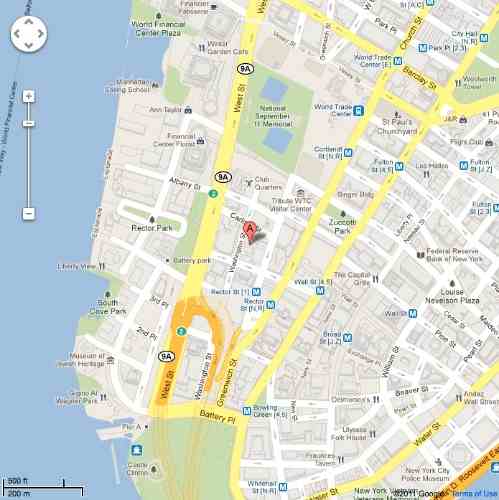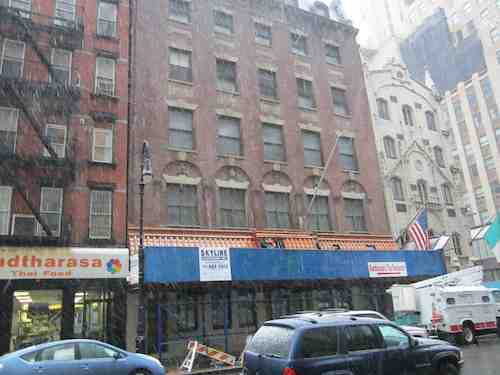Hidden in plain sight on Washington Street, just north of
Rector Street, in lower Manhattan is an endangered piece of history. Three
small privately owned buildings that I learned about during a walking tour in
Saturday 29 October's freak snowstorm.
Each of the buildings is of individual interest and together they
represent the little known story of people who lived in the neighborhood in the
19th and 20th century when the shoreline was a couple of
blocks to the south and west.
The City of New York grew from this neighborhood. By the early 1800's there were grand
waterfront houses such as the Watson House on State Street across from South
Ferry, and mansions along Greenwich Street. The three buildings on Washington Street are not that old
and perhaps not that grand.
The oldest structure, 103 Washington, was built in 1812, but
gained its current landmarked façade in 1925, the same year the completion of
the adjacent Downtown Community Center at 107 Washington was celebrated by
Governor Al Smith and Mayor Jimmy Walker.
The last of the three buildings, 109 Washington Street is a tenement,
probably built towards the end of the 19th century and continuously
inhabited as a residence ever since.


What few people know is that Washington Street was the heart
of "Little Syria," a thriving neighborhood of 3,000 people around the turn of
the 20th century. Similar
to their counterparts on the Lower East Side, the residents of the Lower West
Side were skilled craftsmen, traders and merchants, and dock and service
workers. They were writers and
printers and intellectuals. They built houses of worship like the landmark
Saint George Melkite Church at 103 Washington Street.
The neighborhood had other histories, of course, before it's
heydey as little Syria at the close of the 19th century and into the
20th century. But the
evidence that currently exists is from that era and tells the story of a
neighborhood and its luminaries such as Ameen Rihani who published the first
Arab-American novel in 1911 or the Mokarzel brothers who invented the Linotype
machine for Arab characters and the Pen League, the Arab American Literary
society eventually led by Khalil Gibran.
And those three buildings tell the story of planning and
development in New York. They are
within sight of the Brooklyn Battery Tunnel, a Robert Moses project that took
down the better part of the neighborhood, hastening the relocation of the Arab
American community to Atlantic Avenue in Brooklyn. It is within sight of the World Trade Center which similarly
ripped through the neighborhood in the 1960's. And was, of course, the site of a devastating attack
that is now remaking the neighborhood once again.
People rebuild cities all the time; they destroy and renew
constantly, deciding what is sacred, what is past useful life, and what will
bring better profit or use in another form. At the moment, the vacant lot on the corner of Rector Street
to the south of the church façade at 103 will soon be a 50-story hotel. The lot to the north of the tenement at
109 is also cleared and being used as a staging site for WTC construction. The owners of that parcel own the Downtown
Community Center, the central building of the three. The pressure for change is enormous.
This scenario is repeated throughout our cities all the
time. People value different
aspects of urban opportunity and each negotiates the systems and regulations
and public opinions to promote their own causes and interests. My own bias in this case is clearly on
the side of preservation.
The reasons are spelled out eloquently by many writers who can be found
through the links below.
But here I mean to take a step back from making this
specific case to suggest that our processes and tools for development decisions
are inadequate and unnecessarily contentious. We practice "right-full" development when we might instead
practice negotiated development.
Instead of avoiding people who may disagree, the time has come for urban
governments to imagine a collaborative development process that convenes and
negotiates to a decision. Perhaps
that is too radical, but the public hearing and public comment processes have
collapsed into mutual cynicism. We
need a new process built in the genuine interests of a city, a neighborhood and
people. Ultimately development
isn't about buildings, it is about human beings.
For more information on Little Syria and the three
Washington Street Buildings:

Planetizen Federal Action Tracker
A weekly monitor of how Trump’s orders and actions are impacting planners and planning in America.

Maui's Vacation Rental Debate Turns Ugly
Verbal attacks, misinformation campaigns and fistfights plague a high-stakes debate to convert thousands of vacation rentals into long-term housing.

Restaurant Patios Were a Pandemic Win — Why Were They so Hard to Keep?
Social distancing requirements and changes in travel patterns prompted cities to pilot new uses for street and sidewalk space. Then it got complicated.

In California Battle of Housing vs. Environment, Housing Just Won
A new state law significantly limits the power of CEQA, an environmental review law that served as a powerful tool for blocking new development.

Boulder Eliminates Parking Minimums Citywide
Officials estimate the cost of building a single underground parking space at up to $100,000.

Orange County, Florida Adopts Largest US “Sprawl Repair” Code
The ‘Orange Code’ seeks to rectify decades of sprawl-inducing, car-oriented development.
Urban Design for Planners 1: Software Tools
This six-course series explores essential urban design concepts using open source software and equips planners with the tools they need to participate fully in the urban design process.
Planning for Universal Design
Learn the tools for implementing Universal Design in planning regulations.
Heyer Gruel & Associates PA
JM Goldson LLC
Custer County Colorado
City of Camden Redevelopment Agency
City of Astoria
Transportation Research & Education Center (TREC) at Portland State University
Jefferson Parish Government
Camden Redevelopment Agency
City of Claremont




























